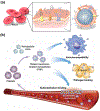Engineering biological interactions on the nanoscale
- PMID: 30390535
- PMCID: PMC6494728
- DOI: 10.1016/j.copbio.2018.10.005
Engineering biological interactions on the nanoscale
Abstract
Nanoparticulate platforms have contributed significantly to the field of biomedical research, demonstrating advantages over traditional modalities in areas such as drug delivery, detoxification, and vaccination. When it comes to the design of nanoparticles, biomimetic strategies have become increasingly popular as a means of promoting effective interactions with biological systems. A recently developed cell membrane-coated nanoparticle platform can leverage the natural interactions that cells engage in with other cells, the extracellular matrix, and biomolecules in order to reduce undesirable nonspecific interactions, while increasing target-specific interactions. Here, we discuss the current state of these biomimetic nanoparticles and highlight how they can be used for various biomedical applications.
Copyright © 2018 Elsevier Ltd. All rights reserved.
Figures




References
-
- Huh AJ, Kwon YJ: “Nanoantibiotics”: a new paradigm for treating infectious diseases using nanomaterials in the antibiotics resistant era. J Control Release 2011, 156:128–145. - PubMed
-
- Fang RH, Zhang L: Nanoparticle-based modulation of the immune system. Annu Rev Chem Biomol Eng 2016, 7:305–326. - PubMed
-
- Byrne JD, Betancourt T, Brannon-Peppas L: Active targeting schemes for nanoparticle systems in cancer therapeutics. Adv Drug Deliv Rev 2008, 60:1615–1626. - PubMed

